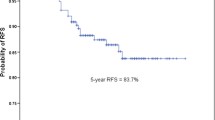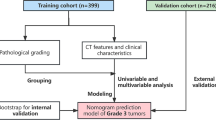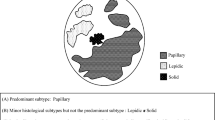Abstract
Objectives
A grading system for pulmonary adenocarcinoma has not been established; hence, the International Association for the Study of Lung Cancer (IASLC) pathology panel developed a new grading system for invasive adenocarcinoma. We aimed to evaluate the prognostic significance of the IASLC grading system for invasive pulmonary adenocarcinoma.
Methods
We conducted a retrospective analysis of 471 Japanese patients with resected lung adenocarcinoma. Tumors were classified in accordance with the IASLC grading system and 2015 World Health Organization classification. We analyzed recurrence-free probability (RFP) and overall survival (OS) using the log-rank test and compared the two grading systems using the Cox proportional hazards model.
Results
Grade 3 tumors of the IASLC system and high-grade tumors of the 2015 World Health Organization classification were present in 38% and 17% of patients, respectively. The 5-year RFP was lower in patients with IASLC Grade 3 tumors (45%) than in patients with IASLC Grade 1 and 2 tumors (91% and 83%, respectively). The 5-year RFP of patients with IASLC Grade 2 tumors (83%) was higher than of those with 2015 World Health Organization intermediate tumors (69%). On multivariate analysis for recurrence, IASLC Grade 3 was an independent prognostic factor of worse RFP. We showed similar results on analysis for the OS.
Conclusions
The prognostic significance of IASLC Grade 3 tumors on recurrence-free probability was confirmed through both univariate and multivariate analyses. Thus, the IASLC Grade 3 tumor is an independent factor of poor prognosis in patients with resected lung adenocarcinoma.


Similar content being viewed by others
References
Travis W, Brambilla E, Nicholson A, Marx A, Burke A. WHO classification of tumours of the lung, pleura, thymus and heart. Lyon: IARC; 2015.
Yoshizawa A, Motoi N, Riely GJ, Sima CS, Gerald WL, Kris MG, et al. Impact of proposed IASLC/ATS/ERS classification of lung adenocarcinoma: prognostic subgroups and implications for further revision of staging based on analysis of 514 stage I cases. Mod Pathol. 2011;24:653–64.
Warth A, Muley T, Meister M, Stenzinger A, Thomas M, Schirmacher P, et al. The novel histologic International Association for the Study of Lung Cancer/American Thoracic Society/European Respiratory Society classification system of lung adenocarcinoma is a stage independent predictor of survival. J Clin Oncol. 2012;30:1438–46.
Tsuta K, Kawago M, Inoue E, Yoshida A, Takahashi F, Sakurai H, et al. The utility of the proposed IASLC/ATS/ERS lung adenocarcinoma subtypes for disease prognosis and correlation of driver gene alterations. Lung Cancer. 2013;81:371–6.
Travis WD, Brambilla E, Noguchi M, Nicholson AG, Geisinger KR, Yatabe Y, et al. International Association for the Study of Lung Cancer/American Thoracic Society/European Respiratory Society international multidisciplinary classification of lung adenocarcinoma. J Thorac Oncol. 2011;6:244–85.
Tsao MS, Marguet S, Le Teuff G, Lantuejoul S, Shepherd FA, Seymour L, et al. Subtype classification of lung adenocarcinoma predicts benefit from adjuvant chemotherapy in patients undergoing complete resection. J Clin Oncol. 2015;33:3439–46.
Yoshizawa A, Sumiyoshi S, Sonobe M, Kobayashi M, Fujimoto M, Kawakami F, et al. Validation of the IASLC/ATS/ERS lung adenocarcinoma classification for prognosis and association with EGFR and KRAS gene mutations: analysis of 440 Japanese patients. J Thorac Oncol. 2013;8:52–61.
Woo T, Okudela K, Mitsui H, Tajiri M, Yamamoto T, Rino Y, et al. Prognostic value of the IASLC/ATS/ERS classification of lung adenocarcinoma in stage I disease of Japanese cases. Pathol Int. 2012;62:785–91.
Warth A, Muley T, Kossakowski C, Stenzinger A, Schirmacher P, Dienemann H, et al. Prognostic impact and clinicopathological correlations of the cribriform pattern in pulmonary adenocarcinoma. J Thorac Oncol. 2015;10:638–44.
Travis WD, World Health Organization, International Agency for Research on Cancer, International Association for the Study of Lung Canceer, International Academy of Pathology. WHO classification of tumors of the lung, pleura, thymus and heart. Lyon and Oxford: IARC Press, Oxford University Press; 2015.
Xu L, Tavora F, Burke A. Histologic features associated with metastatic potential in invasive adenocarcinomas of the lung. Am J Surg Pathol. 2013;37:1100–8.
Mäkinen JM, Laitakari K, Johnson S, Mäkitaro R, Bloigu R, Pääkkö P, et al. Histological features of malignancy correlate with growth patterns and patient outcome in lung adenocarcinoma. Histopathology. 2017;71:425–36.
Moreira AL, Joubert P, Downey RJ, Rekhtman N. Cribriform and fused glands are patterns of high-grade pulmonary adenocarcinoma. Hum Pathol. 2014;45:213–20.
Kuang M, Shen X, Yuan C, Hu H, Zhang Y, Pan Y, et al. Clinical significance of complex glandular patterns in lung adenocarcinoma: clinicopathologic and molecular study in a large series of cases. Am J Clin Pathol. 2018;150:65–73.
Kadota K, Yeh YC, Sima CS, Rusch VW, Moreira AL, Adusumilli PS, et al. The cribriform pattern identifies a subset of acinar predominant tumors with poor prognosis in patients with stage I lung adenocarcinoma: a conceptual proposal to classify cribriform predominant tumors as a distinct histologic subtype. Mod Pathol. 2014;27:690–700.
Kadota K, Kushida Y, Kagawa S, Ishikawa R, Ibuki E, Inoue K, et al. Cribriform subtype is an independent predictor of recurrence and survival after adjustment for the eighth edition of TNM staging system in patients with resected lung adenocarcinoma. J Thorac Oncol. 2019;14:245–54.
Moreira AL, Ocampo PSS, Xia Y, Zhong H, Russell PA, Minami Y, et al. A grading system for invasive pulmonary adenocarcinoma: a proposal from the International Association for the Study of Lung Cancer Pathology Committee. J Thorac Oncol. 2020;15:1599–610.
Amin MB, Edge SB, Greene FL, Byrd DR, Brookland RK, Washington MK, et al. AJCC cancer staging manual. 8th ed. New York: Springer; 2017. p. 431–56.
Funding
This work was supported in part by JSPS KAKENHI (Grant number JP20K07392).
Author information
Authors and Affiliations
Contributions
CY: data curation, formal analysis, investigation, visualization, and writing-original draft preparation. KK: conceptualization, funding acquisition, methodology, writing-reviewing and editing. EI: resources. TG: validation. RH: project administration. HY: supervision.
Corresponding author
Ethics declarations
Conflict of interest
The authors have no conflicts of interest to declare.
Additional information
Publisher's Note
Springer Nature remains neutral with regard to jurisdictional claims in published maps and institutional affiliations.
Supplementary Information
Below is the link to the electronic supplementary material.
Rights and permissions
About this article
Cite this article
Yoshida, C., Yokomise, H., Ibuki, E. et al. High-grade tumor classified by new system is a prognostic predictor in resected lung adenocarcinoma. Gen Thorac Cardiovasc Surg 70, 455–462 (2022). https://doi.org/10.1007/s11748-021-01758-3
Received:
Accepted:
Published:
Issue Date:
DOI: https://doi.org/10.1007/s11748-021-01758-3




